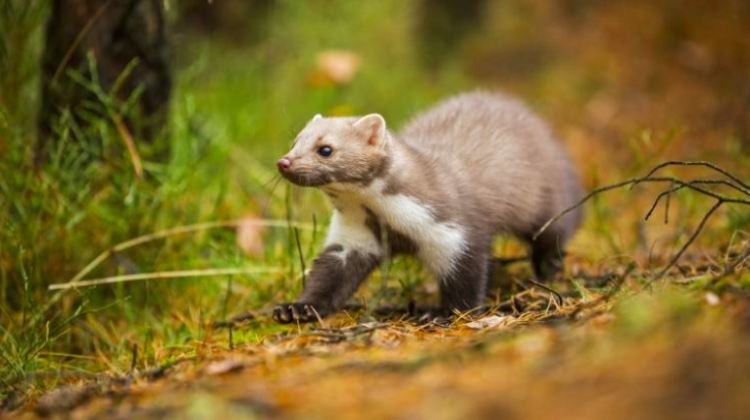Beech martens have been present in north-eastern Poland for only 40 years
 Photo: Fotolia
Photo: Fotolia
Beech martens appeared in the north-east of Poland very recently, in the last 40 years, according to new research on this species. "It is a big surprise, because the common view is that beech martens have been in our environment forever" - says Anna Wereszczuk from the Mammal Research Institute PAS.
Beech marten expansion in north-eastern Poland is a matter of only about 40 years. This is a surprising result, obtained thanks to genetic research, but also confirmed by the analysis of the scientific collection of the Mammal Research Institute PAS and observations, emphasizes Anna Wereszczuk from the Mammal Research Institute PAS in Białowieża.
As part of the study, Anna Wereszczuk and Andrzej Zalewski from the Mammal Research Institute PAS and Raphaël Leblois from the University of Montpellier in France studied the genomes of almost 300 beech martens from all over Poland - mainly the animals killed in road accidents and caught for telemetric research. Researchers were interested in the genetic diversity of Polish beech martens. Such research allows to better understand the population of these animals and the flow of their genes.
It turned out that the spread of beech martens is limited by a dense forest complex. The beech marten population inhabiting villages inside the Białowieża Forest is strongly isolated. The local beech martens almost never wander (scientists describe it as dispersion) through the Białowieża Forest. "Beech martens from villages surrounded by the Białowieża Forest are genetically distinct, definitely different from the populations on the other side of the forest, only 20 km away" - emphasises the scientist.
As a result of increasing proportion of any forests around the beech marten population, the genetic diversity of these animals increases, as scientists observed in the whole country.
"Except for a large, dense forest complex, we have not detected any other barriers in Poland that would limit the dispersion of beech martens and the flow of their genes. These animals move freely between human-populated areas, the only thing that limits them is the geographical distance" - says Anna Wereszczuk.
Genetic analyses allow to state that genetic diversity in beech marten populations in Poland is decreasing in a specific direction: from the south-west to the north-east, which suggests the original direction of expansion. It also turns out that beech marten populations from north-eastern Poland, in comparison to stable populations from central Poland, are still under the influence of the recent "founder effect" and expansion. It is in the north-eastern part of Poland, the edge of the species range in Europe, that the beech marten has only been present for about 40 years. Why so late? Perhaps due to the still large share of forests in this area and relatively lower number of villages. Also probably due to the climate warming, which allowed this species to expand into slightly colder areas of Europe, the study authors suggest.
"It is fascinating that about 3,000 years ago, the primeval forest, which overgrew almost all of Europe, probably blocked the beech marten expansion. They were gradually appearing in new areas of the continent along with neolithic cultures that slowly cleared the forest. And now the last remnant of those forests - the Białowieża Forest - remains the only barrier for this species" - notes Anna Wereszczuk.
She reminds that martens have been present in Europe for thousands of years. First, they colonized the Mediterranean area - the warmest (we know this from archaeological finds), then the Iberian Peninsula, and then they moved north. They could colonize the area of present-day Poland as the thick forests disappeared. "It started approximately 2-3 thousand years ago. Beech martens were following the deforestation, and climate warming was also beneficial for them" - says the biologist from the Mammal Research Institute PAS.
She suggests that martens probably also colonized the rest of Europe thanks to people, who created warm, diverse shelters. Anna Wereszczuk points out that in north-eastern Poland, martens need warm hiding places for the winter even today. "We do not know whether they would survive on this edge of their range without insulated attics or basements" - she says.
The results of beech marten research are a piece of a larger puzzle. According to Anna Wereszczuk, they provide new information, helping to understand the history of this species` expansion in Europe, and how the transformation of a natural environment by humans affects the range of certain species, and even - as in the case of beech martens - allows them to conquer new areas. In addition, the research of the team from the Mammal Research Institute PAS on martens will contribute to understanding what is happening with the marten population in Poland - why their density is growing in Europe and gradually in Poland.
The results of genetic analyses and related conclusions are presented in an article published in the journal BMC Ecology.
PAP - Science in Poland
zan/ ekr/ kap/
tr. RL
Przed dodaniem komentarza prosimy o zapoznanie z Regulaminem forum serwisu Nauka w Polsce.















